-
Notifications
You must be signed in to change notification settings - Fork 2
Game Flow Brainstorms
Brainstorms for how game flow should work. Put designs here which get at the overall structure of the game.
If your design focuses more on specific aspects of the UI (how to present particular information or choices), please put it in UI Brainstorms.
Each turn the user is presented with the relevant indicators for the state of the game world. The player can choose several actions that will affect the state of the world in the next turn. When the turn ends, the next world state is computed based on the current world state, the effects of the player actions and, any new random events that are in effect for the next turn. The player can perform two different types of actions, investment actions and legislative actions.
See also: https://miro.com/app/board/o9J_lejGBBA=/
Investment actions cost money, but will give advantages later on in the game (for example, quarantining people will only become available after the player has invested in quarantaine capacity). Their impact on the simulation parameters will be minimal, tough. Legislative actions, on the other hand, have no cost, but will have much more impact on the simulation parameters.
Ideas on investment cost:
- Could we have a budget based on the "threat level" of the virus? i.e. the budget increases (as a % of GDP) with the perceived threat level of the virus
- a set maximum number of actions each turn (e.g. one legislative action and one investment)?
- A fixed budget (% of GDP) for investments?
To make gameplay more interesting and realistic, the model can be extended. One of the things that make an epidemic so tricky to control is the information delay; when you see people coming into the hospitals, the virus will already have been going around for some time. With Covid this is especially bad. To simulate this, we can introduce a number-of-hospitalizations variable. This will be some fraction of the number-of-infected people with a delay. The player will not have access to the true number of infected people, but only to the number-of-hospitalizations. His/her info will therefore always have a delay. This reflects the situation in the real world, and will also add some suspense to the game, making it much more fun.
We can include an investment action for setting up Testing Capacity; if this is realized, the player will gain access to a new variable, number-of-positively-tested. To simulate asymptomatic cases, this variable will be a fraction of the number-of-infected people. We might also use a delay, as with the hospitalizations. Of course, this variable will be limited by the amount the player has invested in it; if he invested too little, it will reflect the maximum testing capacity, not the fraction of infected cases. This will also make players familiar with exponential growth; I suspect many people will underestimate the amount of capacity they will need.
It would be nice to include wellbeing to our game. Maybe we could model this based on the number of deaths, hospitalizations and specific legislative actions, maybe some investments could have a positive effect.
Every action in the game directly influences some of the simulation parameters R (reproductive number), Alfa (infections from outside), H (hospital capacity) and GDP.
Note: these tables contain the current values from the simulator, and will need to be updated during development.
| Action name | R effect | Alfa effect | GDP effect |
|---|---|---|---|
| Open | = 1.08 | 0 | 0 |
| New Normal | = 1.0 | 0 | 0 |
| Lock Down | = 0.95 | = 0 | - 0.1 |
| Action name | R effect | Alfa effect | H effect | Cost |
|---|---|---|---|---|
| - | - | - | - | - |
| - | - | - | - | - |
In order to make the game realistic, we can use existing research on the effectiveness of interventions. For example, the figure below gives a nice overview (Haug, N. et al. Ranking the effectiveness of worldwide COVID-19 government interventions. Nat. Hum. Behav. 1–10 (2020) doi:10/ghj9f4, https://www.nature.com/articles/s41562-020-01009-0)
